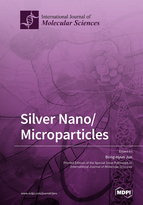Silver Nano/Microparticles: Modification and Applications 2.0
A special issue of International Journal of Molecular Sciences (ISSN 1422-0067). This special issue belongs to the section "Materials Science".
Deadline for manuscript submissions: closed (31 January 2020) | Viewed by 53893
Special Issue Editor
Interests: plasmonic nanomaterials; quantum dots; graphene oxide; SERS
Special Issues, Collections and Topics in MDPI journals
Special Issue Information
Dear Colleagues,
Currently, nano/microparticles are widely used in various fields. Silver particles are one of the most vital materials among the various particles, due to their unique optical-physical-chemical properties. The materials have been proposed for various fields such as bio-sensor, diagnostics, imaging, catalyst and antibacterial. Especially, size-dependent unique plasmonic properties make the particles superior in biomedical applications.
This special issue is aimed to provide a range of original contributions detailing the synthesis, modification, properties and applications in different areas of silver materials, particularly in nanomedicine.
Prof. Bong-Hyun Jun
Guest Editor
Manuscript Submission Information
Manuscripts should be submitted online at www.mdpi.com by registering and logging in to this website. Once you are registered, click here to go to the submission form. Manuscripts can be submitted until the deadline. All submissions that pass pre-check are peer-reviewed. Accepted papers will be published continuously in the journal (as soon as accepted) and will be listed together on the special issue website. Research articles, review articles as well as short communications are invited. For planned papers, a title and short abstract (about 100 words) can be sent to the Editorial Office for announcement on this website.
Submitted manuscripts should not have been published previously, nor be under consideration for publication elsewhere (except conference proceedings papers). All manuscripts are thoroughly refereed through a single-blind peer-review process. A guide for authors and other relevant information for submission of manuscripts is available on the Instructions for Authors page. International Journal of Molecular Sciences is an international peer-reviewed open access semimonthly journal published by MDPI.
Please visit the Instructions for Authors page before submitting a manuscript. There is an Article Processing Charge (APC) for publication in this open access journal. For details about the APC please see here. Submitted papers should be well formatted and use good English. Authors may use MDPI's English editing service prior to publication or during author revisions.
Keywords
- Ag nanoparticles
- Ag microparticles
- Plasmonic nanoparticles
- Biosensor
- Diagnostics
- Imaging
- Bio applications
- Optical property
- Catalyst
- Antibacterial







